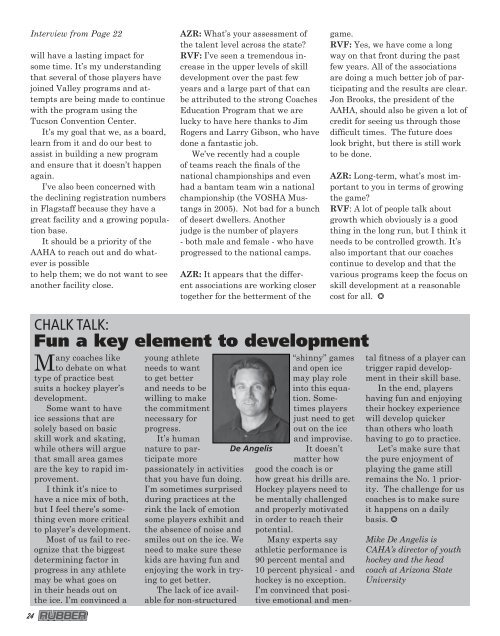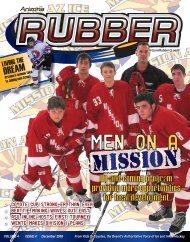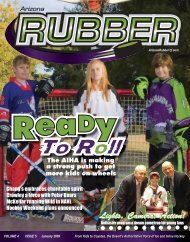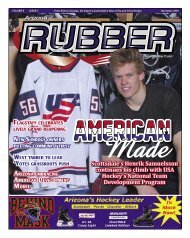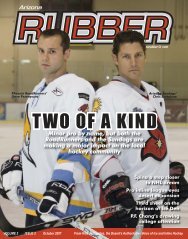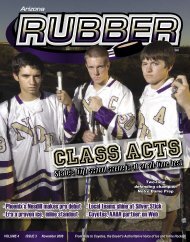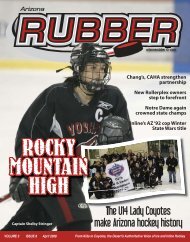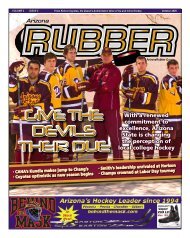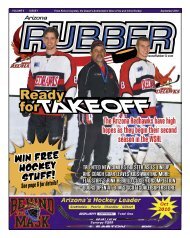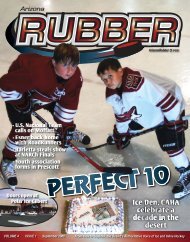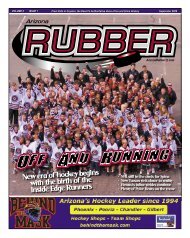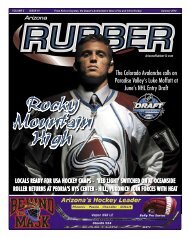Vol 3_No 1 Guts.indd - Rubber Magazine
Vol 3_No 1 Guts.indd - Rubber Magazine
Vol 3_No 1 Guts.indd - Rubber Magazine
You also want an ePaper? Increase the reach of your titles
YUMPU automatically turns print PDFs into web optimized ePapers that Google loves.
24<br />
Interview from Page 22<br />
will have a lasting impact for<br />
some time. It’s my understanding<br />
that several of those players have<br />
joined Valley programs and attempts<br />
are being made to continue<br />
with the program using the<br />
Tucson Convention Center.<br />
It’s my goal that we, as a board,<br />
learn from it and do our best to<br />
assist in building a new program<br />
and ensure that it doesn’t happen<br />
again.<br />
I’ve also been concerned with<br />
the declining registration numbers<br />
in Flagstaff because they have a<br />
great facility and a growing population<br />
base.<br />
It should be a priority of the<br />
AAHA to reach out and do whatever<br />
is possible<br />
to help them; we do not want to see<br />
another facility close.<br />
CHALK TALK:<br />
Many coaches like<br />
to debate on what<br />
type of practice best<br />
suits a hockey player’s<br />
development.<br />
Some want to have<br />
ice sessions that are<br />
solely based on basic<br />
skill work and skating,<br />
while others will argue<br />
that small area games<br />
are the key to rapid improvement.<br />
I think it’s nice to<br />
have a nice mix of both,<br />
but I feel there’s something<br />
even more critical<br />
to player’s development.<br />
Most of us fail to recognize<br />
that the biggest<br />
determining factor in<br />
progress in any athlete<br />
may be what goes on<br />
in their heads out on<br />
the ice. I’m convinced a<br />
AZR: What’s your assessment of<br />
the talent level across the state?<br />
RVF: I’ve seen a tremendous increase<br />
in the upper levels of skill<br />
development over the past few<br />
years and a large part of that can<br />
be attributed to the strong Coaches<br />
Education Program that we are<br />
lucky to have here thanks to Jim<br />
Rogers and Larry Gibson, who have<br />
done a fantastic job.<br />
We’ve recently had a couple<br />
of teams reach the fi nals of the<br />
national championships and even<br />
had a bantam team win a national<br />
championship (the VOSHA Mustangs<br />
in 2005). <strong>No</strong>t bad for a bunch<br />
of desert dwellers. Another<br />
judge is the number of players<br />
- both male and female - who have<br />
progressed to the national camps.<br />
AZR: It appears that the different<br />
associations are working closer<br />
together for the betterment of the<br />
Fun a key element to development<br />
young athlete<br />
needs to want<br />
to get better<br />
and needs to be<br />
willing to make<br />
the commitment<br />
necessary for<br />
progress.<br />
It’s human<br />
nature to participate<br />
more<br />
passionately in activities<br />
that you have fun doing.<br />
I’m sometimes surprised<br />
during practices at the<br />
rink the lack of emotion<br />
some players exhibit and<br />
the absence of noise and<br />
smiles out on the ice. We<br />
need to make sure these<br />
kids are having fun and<br />
enjoying the work in trying<br />
to get better.<br />
The lack of ice available<br />
for non-structured<br />
De Angelis<br />
“shinny” games<br />
and open ice<br />
may play role<br />
into this equation.Sometimes<br />
players<br />
just need to get<br />
out on the ice<br />
and improvise.<br />
It doesn’t<br />
matter how<br />
good the coach is or<br />
how great his drills are.<br />
Hockey players need to<br />
be mentally challenged<br />
and properly motivated<br />
in order to reach their<br />
potential.<br />
Many experts say<br />
athletic performance is<br />
90 percent mental and<br />
10 percent physical - and<br />
hockey is no exception.<br />
I’m convinced that positive<br />
emotional and men-<br />
game.<br />
RVF: Yes, we have come a long<br />
way on that front during the past<br />
few years. All of the associations<br />
are doing a much better job of participating<br />
and the results are clear.<br />
Jon Brooks, the president of the<br />
AAHA, should also be given a lot of<br />
credit for seeing us through those<br />
diffi cult times. The future does<br />
look bright, but there is still work<br />
to be done.<br />
AZR: Long-term, what’s most important<br />
to you in terms of growing<br />
the game?<br />
RVF: A lot of people talk about<br />
growth which obviously is a good<br />
thing in the long run, but I think it<br />
needs to be controlled growth. It’s<br />
also important that our coaches<br />
continue to develop and that the<br />
various programs keep the focus on<br />
skill development at a reasonable<br />
cost for all. ❂<br />
tal fi tness of a player can<br />
trigger rapid development<br />
in their skill base.<br />
In the end, players<br />
having fun and enjoying<br />
their hockey experience<br />
will develop quicker<br />
than others who loath<br />
having to go to practice.<br />
Let’s make sure that<br />
the pure enjoyment of<br />
playing the game still<br />
remains the <strong>No</strong>. 1 priority.<br />
The challenge for us<br />
coaches is to make sure<br />
it happens on a daily<br />
basis. ❂<br />
Mike De Angelis is<br />
CAHA’s director of youth<br />
hockey and the head<br />
coach at Arizona State<br />
University


